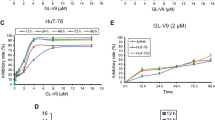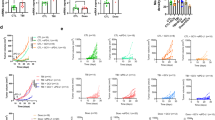Abstract
Cellular senescence is a stable cell cycle arrest, usually in response to internal and/or external stress, including telomere dysfunction, abnormal cellular growth, and DNA damage. Several chemotherapeutic drugs, such as melphalan (MEL) and doxorubicin (DXR), induce cellular senescence in cancer cells. However, it is not clear whether these drugs induce senescence in immune cells. We evaluated the induction of cellular senescence in T cells were derived from human peripheral blood mononuclear cells (PBMNCs) in healthy donors using sub-lethal doses of chemotherapeutic agents. The PBMNCs were kept overnight in RPMI 1640 medium with 2% phytohemagglutinin and 10% fetal bovine serum and then cultured in RPMI 1640 with 20 ng/mL IL-2 and sub-lethal doses of chemotherapeutic drugs (2 μM MEL and 50 nM DXR) for 48 h. Sub-lethal doses of chemotherapeutic agents induced phenotypes associated with senescence, such as the formation of γH2AX nuclear foci, cell proliferation arrest, and induction of senescence-associated beta-galactosidase (SA-β-Gal) activity, (control vs. MEL, DXR; median mean fluorescence intensity (MFI) 1883 (1130–2163) vs. 2233 (1385–2254), 2406.5 (1377–3119), respectively) in T cells. IL6 and SPP1 mRNA, which are senescence-associated secretory phenotype (SASP) factors, were significantly upregulated by sublethal doses of MEL and DXR compared to the control (P = 0.043 and 0.018, respectively). Moreover, sub-lethal doses of chemotherapeutic agents significantly enhanced the expression of programmed death 1 (PD-1) on CD3 + CD4 + and CD3 + CD8 + T cells compared to the control (CD4 + T cells; P = 0.043, 0.043, and 0.043, respectively, CD8 + T cells; P = 0.043, 0.043, and 0.043, respectively). Our results suggest that sub-lethal doses of chemotherapeutic agents induce senescence in T cells and tumor immunosuppression by upregulating PD-1 expression on T cells.



Similar content being viewed by others
References
di DaddaFagagna F. Living on a break: cellular senescence as a DNA-damage response. Nat Rev Cancer. 2008;8:512–22.
Lowe SW, Cepero E, Evan G. Intrinsic tumour suppression. Nature. 2004;432:307–15.
Kurz DJ, Decary S, Hong Y, Erusalimsky JD. Senescence-associated (beta)-galactosidase reflects an increase in lysosomal mass during replicative ageing of human endothelial cells. J Cell Sci. 2000;113:3613–22.
Dimri GP, Lee X, Basile G, Acosta M, et al. A biomarker that identifies senescent human cells in culture and in aging skin in vivo. Proc Natl Acad Sci USA. 1995;92:9363–7.
Srivastava M, Raghavan SC. DNA double-strand break repair inhibitors as cancer therapeutics. Chem Biol. 2015;22:17–29.
Celeste A, Fernandez-Capetillo O, Kruhlak MJ, et al. Histone H2AX phosphorylation is dispensable for the initial recognition of DNA breaks. Nat Cell Biol. 2003;5:675–9.
Childs BG, Baker DJ, Kirkland JL, Campisi J, van Deursen JM. Senescence and apoptosis: dueling or complementary cell fates? EMBO Rep. 2014;15:1139–53.
Zhang J, He T, Xue L, Guo H. Senescent T cells: a potential biomarker and target for cancer therapy. EBioMedicine. 2021;68:103409.
Brenchley JM, Karandikar NJ, Betts MR, et al. Expression of CD57 defines replicative senescence and antigen-induced apoptotic death of CD8+ T cells. Blood. 2003;101:2711–20.
Henson SM, Franzese O, Macaulay R, et al. KLRG1 signaling induces defective Akt (ser473) phosphorylation and proliferative dysfunction of highly differentiated CD8+ T cells. Blood. 2009;113:6619–28.
Huang B, Liu R, Wang P, et al. CD8+CD57+ T cells exhibit distinct features in human non-small cell lung cancer. J Immunother Cancer. 2020;8:e000639.
Trintinaglia L, Bandinelli LP, Grassi-Oliveira R, et al. Features of immunosenescence in women newly diagnosed with breast cancer. Front Immunol. 2018;9:1651.
Akagi J, Baba H. Prognostic value of CD57(+) T lymphocytes in the peripheral blood of patients with advanced gastric cancer. Int J Clin Oncol. 2008;13:528–35.
Tan J, Chen S, Lu Y, et al. Higher PD-1 expression concurrent with exhausted CD8+ T cells in patients with de novo acute myeloid leukemia. Chin J Cancer Res. 2017;29:463–70.
Saavedra D, García B, Lorenzo-Luaces P, et al. Biomarkers related to immunosenescence: relationships with therapy and survival in lung cancer patients. Cancer Immunol Immunother. 2016;65:37–45.
Onyema OO, Decoster L, Njemini R, et al. Shifts in subsets of CD8+ T-cells as evidence of immunosenescence in patients with cancers affecting the lungs: an observational case-control study. BMC Cancer. 2015;15:1016.
Bruni E, Cazzetta V, Donadon M, et al. Chemotherapy accelerates immune-senescence and functional impairments of Vδ2pos T cells in elderly patients affected by liver metastatic colorectal cancer. J Immunother Cancer. 2019;7:347.
Shimatani K, Nakashima Y, Hattori M, Hamazaki Y, Minato N. PD-1+ memory phenotype CD4+ T cells expressing C/EBPalpha underlie T cell immunodepression in senescence and leukemia. Proc Natl Acad Sci USA. 2009;106:15807–12.
Gordon RR, Nelson PS. Cellular senescence and cancer chemotherapy resistance. Drug Resist Updat. 2012;15:123–31.
Plunkett FJ, Franzese O, Belaramani LL, et al. The impact of telomere erosion on memory CD8+ T cells in patients with X-linked lymphoproliferative syndrome. Mech Ageing Dev. 2005;126:855–65.
Ye J, Huang X, Hsueh EC, et al. Human regulatory T cells induce T-lymphocyte senescence. Blood. 2012;120:2021–31.
Liu W, Stachura P, Xu HC, Bhatia S, Borkhardt A, Lang PA, Pandyra AA. Senescent tumor CD8+ T cells: mechanisms of induction and challenges to immunotherapy. Cancers (Basel). 2020;12:2828.
Hoare M, Shankar A, Shah M, et al. γ-H2AX+CD8+ T lymphocytes cannot respond to IFN-α, IL-2 or IL-6 in chronic hepatitis C virus infection. J Hepatol. 2013;58(5):868–74.
Liu X, Mo W, Ye J, et al. Regulatory T cells trigger effector T cell DNA damage and senescence caused by metabolic competition. Nat Commun. 2018;9:249.
Tahir S, Fukushima Y, Sakamoto K, et al. A CD153+CD4+ T follicular cell population with cell-senescence features plays a crucial role in lupus pathogenesis via osteopontin production. J Immunol. 2015;194:5725–35.
Callender LA, Carroll EC, Bober EA, Akbar AN, Solito E, Henson SM. Mitochondrial mass governs the extent of human T cell senescence. Aging Cell. 2020;19(2):e13067.
.
Mondal AM, Horikawa I, Pine SR, et al. p53 isoforms regulate aging- and tumor-associated replicative senescence in T lymphocytes. J Clin Invest. 2013;123:5247–57.
Henson SM, Lanna A, Riddell NE, et al. signaling inhibits mTORC1-independent autophagy in senescent human CD8+ T cells. J Clin Invest. 2014;124:4004–16.
Fukushima Y, Minato N, Hattori M. The impact of senescence-associated T cells on immunosenescence and age-related disorders. Inflamm Regen. 2018;38:24.
Haymaker C, Wu R, Bernatchez C, Radvanyi L. PD-1 and BTLA and CD8(+) T-cell “exhaustion” in cancer: “Exercising” an alternative viewpoint. Oncoimmunology. 2012;1:735–8.
Janelle V, Neault M, Lebel MÈ, et al. p16INK4a Regulates Cellular Senescence in PD-1-Expressing Human T Cells. Front Immunol. 2021;12:698565.
Sharpless NE, Sherr CJ. Forging a signature of in vivo senescence. Nat Rev Cancer. 2015;15:397–408.
Muroyama Y, Manne S, Wellhausen N, et al. Induction of a CD8 T cell intrinsic DNA damage and repair response is associated with clinical response to PD-1 blockade in uterine cancer. bioRxiv. doi: https://doi.org/10.1101/2022.04.16.488552.
Petersen CT, Hassan M, Morris AB, et al. Improving T-cell expansion and function for adoptive T-cell therapy using ex vivo treatment with PI3Kδ inhibitors and VIP antagonists. Blood Adv. 2018;2:210–23.
Mika T, Ladigan-Badura S, Maghnouj A, et al. Altered T-lymphocyte biology following high-dose melphalan and autologous stem cell transplantation with implications for adoptive T-cell therapy. Front Oncol. 2020;10:568056.
Rodriguez IJ, Lalinde Ruiz N, Llano León M, et al. Immunosenescence study of T cells: a systematic review. Front Immunol. 2021;11:604591.
Reece PA, Hill HS, Green RM, et al. Renal clearance and protein binding of melphalan in patients with cancer. Cancer Chemother Pharmacol. 1988;22:348–52.
Mross K, Maessen P, van der Vijgh WJ, Gall H, Boven E, Pinedo HM. Pharmacokinetics and metabolism of epidoxorubicin and doxorubicin in humans. J Clin Oncol. 1988;6:517–26.
Funding
The authors declare that no funds, grants, or other support were received during the preparation of this manuscript.”
Author information
Authors and Affiliations
Contributions
All authors contributed to the study conception and design. TK designed the research, performed most of the experiments, performed analysis and wrote the manuscript; MA-S, RI, YM, YM, NG and TO performed some of the experiments and data collection; AY, IM, HH and NT collected the samples; HM and TS supervised all of the research work.
Corresponding author
Ethics declarations
Conflict of interest
The authors declare no conflicts of interest.
Ethical approval
All procedures performed in studies involving human participants were in accordance with the ethical standards of the Institutional Review Board of Gunma University Hospital (Approval # HS2019-247) and with the 1964 Declaration of Helsinki.
Informed consent
Informed consent was obtained from all individual participants included in the study.
Additional information
Publisher's Note
Springer Nature remains neutral with regard to jurisdictional claims in published maps and institutional affiliations.
Rights and permissions
Springer Nature or its licensor (e.g. a society or other partner) holds exclusive rights to this article under a publishing agreement with the author(s) or other rightsholder(s); author self-archiving of the accepted manuscript version of this article is solely governed by the terms of such publishing agreement and applicable law.
About this article
Cite this article
Kasamatsu, T., Awata-Shiraiwa, M., Ishihara, R. et al. Sub-lethal doses of chemotherapeutic agents induce senescence in T cells and upregulation of PD-1 expression. Clin Exp Med 23, 2695–2703 (2023). https://doi.org/10.1007/s10238-023-01034-z
Received:
Accepted:
Published:
Issue Date:
DOI: https://doi.org/10.1007/s10238-023-01034-z




